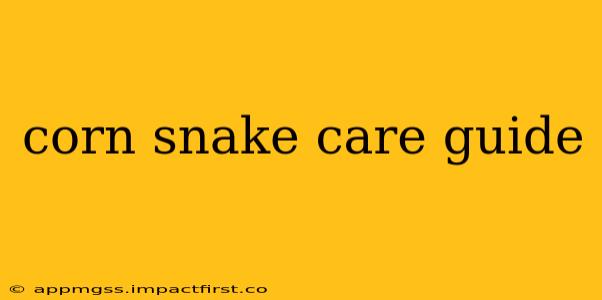Corn snakes ( Pantherophis guttatus) are popular pets due to their docile nature, relatively small size, and stunning array of colors and patterns. However, providing proper care is crucial for their health and well-being. This comprehensive guide covers everything you need to know to become a responsible corn snake owner.
What You Need Before Getting a Corn Snake
Before bringing a corn snake home, ensure you have everything necessary to create a safe and thriving environment. This includes:
-
Enclosure: A 20-gallon long tank is suitable for an adult corn snake. Juveniles can initially live in a smaller enclosure, but upgrading is essential as they grow. Ensure proper ventilation.
-
Substrate: Aspen shavings, cypress mulch, or paper towels are excellent choices. Avoid cedar or pine shavings, as they can be harmful.
-
Hides: Provide at least two hides – one on the warm side and one on the cool side – to allow your snake to thermoregulate and feel secure. These can be commercially available hides or even appropriately sized containers.
-
Water Bowl: A large enough water bowl for your snake to soak in if needed. Fresh water should be provided daily.
-
Heat Source: A heat lamp or under-tank heater (UTH) is necessary to maintain a temperature gradient within the enclosure. The warm side should be around 88-92°F (31-33°C), and the cool side around 75-80°F (24-27°C). Always use a thermostat to prevent overheating.
-
Thermometer and Hygrometer: Essential for monitoring temperature and humidity levels. Maintaining proper humidity (around 40-60%) is crucial for shedding.
Feeding Your Corn Snake
Corn snakes are carnivores and thrive on a diet of appropriately sized rodents. The size of the prey should be roughly the same diameter as the widest part of your snake’s body.
How often should I feed my corn snake?
- Juveniles (under 1 year): Feed once or twice a week.
- Adults: Feed once a week or every 10 days. Adult corn snakes can go longer between feedings, especially if they are fully grown.
What kind of food should I feed my corn snake?
Frozen-thawed rodents are the recommended food source. Avoid feeding live prey, as this poses a risk of injury to your snake.
How do I thaw frozen rodents?
Thaw rodents in the refrigerator overnight before feeding. Never thaw them at room temperature or in warm water.
Handling Your Corn Snake
Corn snakes are generally docile, but proper handling techniques are still important.
How often should I handle my corn snake?
Handle your corn snake regularly to build trust and socialization, but avoid over-handling, especially when it is shedding. Young snakes may require less handling initially.
How should I handle my corn snake?
Support your corn snake’s body from underneath to avoid injury. Avoid sudden movements or loud noises.
Common Corn Snake Health Problems
While generally hardy, corn snakes can still experience health problems. Common issues include:
- Shedding problems: Improper humidity can lead to difficulty shedding.
- Respiratory infections: Often caused by stress or poor hygiene.
- Parasites: Regular vet checks can help prevent and detect parasitic infestations.
What are the signs of a sick corn snake?
Signs of illness include lethargy, loss of appetite, unusual shedding patterns, or respiratory issues. Consult a veterinarian specializing in reptiles immediately if you suspect your corn snake is unwell.
Cleaning Your Corn Snake's Enclosure
Regular cleaning is essential to maintain a hygienic environment. Spot clean daily, removing any feces or uneaten food. Completely disinfect and replace substrate every 2-4 weeks.
How Often Do Corn Snakes Shed?
Corn snakes shed their skin regularly, typically every 4-6 weeks. The frequency can vary depending on age and growth rate.
What is the Lifespan of a Corn Snake?
Corn snakes can live for 15-20 years, sometimes even longer, with proper care.
This comprehensive corn snake care guide provides a solid foundation for responsible ownership. Remember that continuous learning and research are vital to ensure your corn snake thrives for many years to come. Always consult with a reptile veterinarian for any concerns about your snake’s health.
